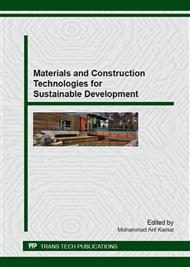[1]
S. Liuzzi, Experimental Investigation on Earthen Building Materials. Hygrothermal and Physical performances. 2012, LAP Lambert Academic Publishing.
Google Scholar
[2]
J.E. Oti, J.M. Kinuthia, J. Bai, Design thermal values for unfired clay bricks. Materials and Design 31 (2010) 104–112.
DOI: 10.1016/j.matdes.2009.07.011
Google Scholar
[3]
OtiJ.E., Kinuthia J.M., Bai J., Engineering properties of unfired clay masonry bricks. Engineering Geology 107 (2009) 130–139.
DOI: 10.1016/j.enggeo.2009.05.002
Google Scholar
[4]
M. L. Parra Saldivar, W. Batty, Thermal behaviour of adobe constructions. Building and Environment 41 (2006) 1892–(1904).
DOI: 10.1016/j.buildenv.2005.07.021
Google Scholar
[5]
D. Allinson, M. Hall, Hygrothermal analysis of a stabilised rammed earth test building in the UK. Energy and Buildings 42 (2010) 845–852.
DOI: 10.1016/j.enbuild.2009.12.005
Google Scholar
[6]
M. Hall, D. Allinson, Analysis of the hygrothermal functional properties of stabilised rammed earth materials. Building and Environment 44 (2009) 1935–(1942).
DOI: 10.1016/j.buildenv.2009.01.007
Google Scholar
[7]
G. Minke, Building with earth. Design and Technology of a Sustainable Architecture. Birkhauser, (2006).
Google Scholar
[8]
S. Liuzzi, M.R. Hall, P. Stefanizzi, S.P. Casey, Hygrothermal behaviour and relative humidity buffering of unfired and hydrated lime-stabilised clay composites in a Mediterranean climate. Building and Environment 61 (2013) 82-92.
DOI: 10.1016/j.buildenv.2012.12.006
Google Scholar
[9]
G. Scudo G., B. Narici, C. Talamo, Costruire con la terra. Tecniche costruttive, campi di utilizzo e prestazioni. Napoli, Esselibri Spa, (2004).
Google Scholar
[10]
M. Achenza M., U. Sanna. Il manuale tematico della terra cruda. DEI, Tipografia del genio civile, (2008).
Google Scholar
[11]
T. Ashour, W. Wu. An experimental study on shrinkage of earth plaster with natural fibres for straw bale buildings. International Journal of Sustainable Engineering 3 (2010), 299-304.
DOI: 10.1080/19397038.2010.504379
Google Scholar
[12]
T. Ashour, H. Wieland, H. Georg, FJ. Bockisch, W. Wu. The influence of natural reinforcement fibres on insulation values of earth plaster for straw bale buildings. Materials and Design 31 (2010) 4676–4685.
DOI: 10.1016/j.matdes.2010.05.026
Google Scholar
[13]
T. Ashour, H. Georg, W. Wu, An experimental investigation on equilibrium moisture content of earth plaster with natural reinforcement fibres for straw bale buildings. Applied Thermal Engineering, 31 (2011) 293-303.
DOI: 10.1016/j.applthermaleng.2010.09.009
Google Scholar
[14]
Ente Nazionale Italiano di Unificazione. 2001. UNI EN ISO 12571, Hygrothermal performance of building materials and products - Determination of hygroscopic sorption properties (in Italian).
Google Scholar
[15]
H. M Künzel, Simultaneous heat and moisture transport in building components. 1995, Dissertation. University of Stuttgart, Stuttgart.
Google Scholar
[16]
Ente Nazionale Italiano di Unificazione. 2008, UNI EN 1015-19, Methods of test for mortar for masonry - Determination of water vapour permeability of hardened rendering and plastering mortars (in Italian).
DOI: 10.3403/01541425
Google Scholar
[17]
Ente Nazionale Italiano di Unificazione. 2004, UNI EN 1015-18, Methods of test for mortar for masonry - Determination of water absorption coefficient due to capillary action of hardened mortar (in Italian).
DOI: 10.3403/02720093u
Google Scholar
[18]
Ente Nazionale Italiano di Unificazione. 2001, UNI EN ISO 12570, Hygrothermal performance of building materials and products - Determination of moisture content by drying at elevated temperature (in Italian).
DOI: 10.3403/01700161u
Google Scholar
[19]
Ente Nazionale Italiano di Unificazione. 2007, UNI EN 1015-11, Methods of test for mortar for masonry. Part 11: Determination of flexural and compressive strength of hardened mortar (in Italian).
DOI: 10.3403/01905442
Google Scholar
[20]
J.A. Calabria , W. L Vasconcelos, A.R. Boccaccini , Microstructure and chemical degradation of adobe and clay bricks. Ceramics International, 35 (2009) p.665–671.
DOI: 10.1016/j.ceramint.2008.01.026
Google Scholar
[21]
A.A. R Correa, V.H. Teixeira, S.P. Lopes, M.S. de Oliveira. (2006).
Google Scholar
[22]
H. Binici, O. Aksogan, T. Shah. Investigation of fibre reinforced mud brick as a building material. Construction and Building Materials, 19 (2005) 313–318.
DOI: 10.1016/j.conbuildmat.2004.07.013
Google Scholar


